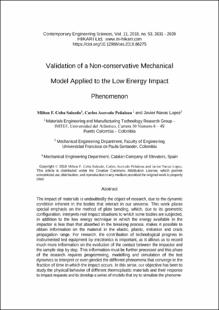Mostrar el registro sencillo del ítem
Validation of a non-conservative mechanical model applied to the low energy impact phenomenon
| dc.contributor.author | Coba Salcedo, Milton Fabian | |
| dc.contributor.author | Acevedo Peñaloza, Carlos Humberto | |
| dc.contributor.author | Lopez Navas, Javier | |
| dc.date.accessioned | 2021-12-12T16:03:27Z | |
| dc.date.available | 2021-12-12T16:03:27Z | |
| dc.date.issued | 2018-07-17 | |
| dc.identifier.uri | http://repositorio.ufps.edu.co/handle/ufps/6379 | |
| dc.description.abstract | The impact of materials is undoubtedly the object of research, due to the dynamic condition inherent in the bodies that interact in our universe. This work places special emphasis on the method of plate bending, which, due to its geometric configuration, interprets real impact situations to which some bodies are subjected, in addition to the low energy technique in which the energy available in the impactor is less than that absorbed in the breaking process, makes it possible to obtain information on the material in the elastic, plastic, initiation and crack propagation range. For research, the contribution of technological progress in instrumented test equipment by electronics is important, as it allows us to record much more information on the evolution of the contact between the impactor and the sample step by step. This information must be further processed and this phase of the research requires programming, modelling and simulation of the test dynamics to interpret or even predict the different phenomena that converge in the fraction of time in which the impact occurs. In this sense, our objective has been to study the physical behavior of different thermoplastic materials and their response to impact requests and to develop a series of models that try to simulate the phenomenon, in order to help us establish what happens at each stage of it, this is achieved using powerful mathematical tools, new contributions from the scientific community and continuous experimentation achieved in the laboratory. So that more knowledge can be obtained in this field. | eng |
| dc.format.extent | 09 páginas | spa |
| dc.format.mimetype | application/pdf | spa |
| dc.language.iso | eng | spa |
| dc.publisher | Contemporary Engineering Sciences | spa |
| dc.relation.ispartof | Contemporary Engineering Sciences | |
| dc.rights | © 2018 Milton F. Coba Salcedo, Carlos Acevedo Penaloza and Javier Navas Lopez. This article is distributed under the Creative Commons Attribution License, which permits unrestricted use, distribution, and reproduction in any medium, provided the original work is properly cited. | eng |
| dc.source | http://www.m-hikari.com/ces/ces2018/ces53-56-2018/86275.html | spa |
| dc.title | Validation of a non-conservative mechanical model applied to the low energy impact phenomenon | eng |
| dc.type | Artículo de revista | spa |
| dcterms.references | M. A. Macaulay, Introduction to Impact Engineering, 1st Edition, Springer, New York, Editorial Chapman and Hall, 1987. https://doi.org/10.1007/978-94-009-3159-6 | spa |
| dcterms.references | W. Goldsmith, Impact : The Physical Theory and Behaviour of Colliding Solids, London: Edward Arnold Ltd., 1960. | spa |
| dcterms.references | S. Turner, Mechanical Testing of Plastics, 2nd Edition, The plastics and Rubber institute, Londres, 1983. | spa |
| dcterms.references | T A. Oswald and G. Menges, eds., Material Science of Polymers for Engineers, 2nd Edition, Hanser, Munich, 2003. | spa |
| dcterms.references | J. G. Williams, Fracture Mechanics of Polymers, 1st Edition, Ellis Horwood Series in Engineering Science, Chichester, 1994. | spa |
| dcterms.references | A. B. Martínez, Técnicas de impacto de materiales plásticos y compuestos, 1ª. | spa |
| dcterms.references | Edición, Publicaciones Universidad Politécnica de Cataluña, Barcelona, 1988. | spa |
| dcterms.references | M. Sánchez-Soto, Comportamiento Mecánico y Fractura de Mezclas de Poliestireno y Microesferas de Vidrio, Diss., Universitat Politècnica de Catalunya, CCP, UPC Terrassa, 2000. | spa |
| dcterms.references | O. A. Jiménez Arévalo, Comportamiento a la Fractura De Composites Con Matriz de Poliestireno, Diss., Universidad Politécnica de Cataluña, Terrassa, 2002. | spa |
| dcterms.references | J. Gámez Pérez, Relación Estructura-Propiedad En Placas Y Láminas De Polipropileno Y Copolímeros En Bloque Etileno-Propileno Obtenidas Por Validation of a non-conservative mechanical model | spa |
| dcterms.references | Javier Antonio Navas López, Estudio, Evaluación y Modelado Del Comportamiento de Indentación y Flexión-Indentación a Impacto de Baja Energía de Materiales Termoplásticos, Diss., Universidad Politecnica de Cataluña. Barcelona, 2008. | spa |
| dcterms.references | R. J. Roark, Formulas for Stress and Strain, Mc Graw Hill, New York, 1954. | spa |
| dcterms.references | W. C. Young, Roark’s Formulas for Stress and Strain. 6 Edition, Mc Graw Hill, New York, 1989. | spa |
| dc.identifier.doi | https://doi.org/10.12988/ces.2018.86275 | |
| dc.publisher.place | Bulgaria | spa |
| dc.relation.citationedition | Vol.11 No.53.(2018) | spa |
| dc.relation.citationendpage | 2639 | spa |
| dc.relation.citationissue | 53(2018) | spa |
| dc.relation.citationstartpage | 2631 | spa |
| dc.relation.citationvolume | 11 | spa |
| dc.relation.cites | Salcedo, M. F. C., Peñaloza, C. A., & Lopez, J. N. (2018). Validation of a Non-conservative Mechanical Model Applied to the Low Energy Impact Phenomenon. | |
| dc.relation.ispartofjournal | Contemporary Engineering Sciences | spa |
| dc.rights.accessrights | info:eu-repo/semantics/openAccess | spa |
| dc.rights.creativecommons | Atribución-NoComercial-SinDerivadas 4.0 Internacional (CC BY-NC-ND 4.0) | spa |
| dc.subject.proposal | Impact | eng |
| dc.subject.proposal | Charpy | eng |
| dc.subject.proposal | Plastics | eng |
| dc.subject.proposal | Non conservative models | eng |
| dc.type.coar | http://purl.org/coar/resource_type/c_6501 | spa |
| dc.type.content | Text | spa |
| dc.type.driver | info:eu-repo/semantics/article | spa |
| dc.type.redcol | http://purl.org/redcol/resource_type/ART | spa |
| oaire.accessrights | http://purl.org/coar/access_right/c_abf2 | spa |
| oaire.version | http://purl.org/coar/version/c_970fb48d4fbd8a85 | spa |
| dc.type.version | info:eu-repo/semantics/publishedVersion | spa |










